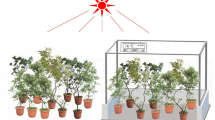Summary
Oxygen concentrations were measured at monthly intervals in deep peat in plots in which the water-tables are maintained artificially at levels ranging in depth from 11 cm to 33 cm below the surface. Good correlation was observed between weight of roots of 11 year oldPinus contorta in these plots and oxygen concentrations in different horizons at all times of the year, although strongest correlations coincided with the winter months when oxygen concentrations are lowest, indicating that the root pattern is determined more by adverse rather than optimum seasonal conditions. re]19760920
Similar content being viewed by others
References
Armstrong, W., Oxygen diffusion from the roots of some British Bog Plants. Nature London 204, 801–802 (1964).
Boggie, R., Effect of water-table height on root development ofPinus contorta on deep peat in Scotland. Oikos 23, 304–312 (1972).
Boggie, R., Response of seedlings ofPinus contorta andPicea sitchensis to oxygen concentrations in culture solution. New Phytol. 73, 467–473 (1974).
Boggie, R. and Miller, H. G., Effect of water table height on growth ofPinus contorta on deep peat. Proc. N.E.R.C. Symp. For., Edinburgh (1975).
Boggie, R. and Miller, H. G., Growth ofPinus contorta at different watertable levels in deep blanket peat. Forestry (in press).
Grable, A. R., Soil aeration and plant growth. Adv. Agrom., 18, 57 (1966).
Heikurainen, L., Päivänen, J. and Sarasto, J., Ground water-table and water content in peat soil. Acta For. Fenn. 77, 1–18 (1964).
Kozlowski, T. T., Tree growth, action and interaction of soil and other factors. J. For. 53, 508–512 (1955).
Martin, M. H. and Pigott, C. D., A simple method of measuring carbon dioxide in soils. J. Ecol. 53, 153–157 (1965).
Myers, L. E. and VanBavel, C. H. M., Measurement and evaluation of water table elevations. Trans. 5th Congr. Intern. Comm. Irrigation Drainage, R. 8, Q.17, 109–119 (1963).
Rogers, J. A. and King, J., The distribution and abundance of grassland species in hill pasture in relation to soil aeration and base status. J. Ecol. 60, 1–9 (1972).
Sheikh, K. H., The response ofMolinia caerulea andErica tetralix to soil aeration and related factors. II Base concentrations in soil air and soil water. J. Ecol. 57, 727–737 (1969).
Sheikh, K. H., The response ofMolinia caerulae andErica tetralix to soil aeration and related factors. III. Effects of different gas concentrations on growth in solution culture and general conclusions. J. Ecol. 58, 141–155 (1970).
Sutton, R. F., Form and development of conifer root systems. Techn. Commun. Commonw. For Bur. No. 7, 1–131 (1969).
Author information
Authors and Affiliations
Rights and permissions
About this article
Cite this article
Boggie, R. Water-table depth and oxygen content of deep peat in relation to root growth ofPinus contorta . Plant Soil 48, 447–454 (1977). https://doi.org/10.1007/BF02187253
Received:
Issue Date:
DOI: https://doi.org/10.1007/BF02187253




